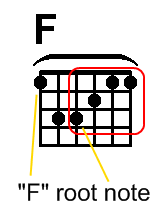Naming Chord Root Notes
Lesson Goals:
♦ Understand what a root note is
♦ Learn root notes for the C-A-G-E-D open chords
♦ Be able to identify root notes for all learned chords
Now that you have learned the notes on the 6th and 5th strings it's time to put that knowledge to work! Although this may seem, at first glance, to border on "mundane music theory" - this is really very easy and it is extremely important to how well you progress on the guitar.
Every house, building or structure is built upon a foundation. It can't stand without one. The same holds true for music chords and scales. The foundation for a chord or scale is known as the "root".
The root for a chord or scale is usually the first or lowest note. For example, the "E" chord starts, at its foundation, with the root note of "E". The same holds true for an "E" scale. (more on scales later)
Let's look at the diagram of the C-A-G-E-D open chords that we learned about in a previous lesson.

We will look first at the "C" chord. The "C" chord starts with the note on the 3rd fret of the 5th string. That note, as you will recall is a "C" note and is the foundation or root of the chord.
The "A" chord starts on the open 5th string and we know that is an "A" note so it is the root of the "A" chord.
You can see that the same is true for the "G", "E" and "D" chords as well. Just note that the "D" chord starts with the open 4th string and you will remember that this is a "D" note (from the Tuning Strings section) even though we did not cover the notes on the 4th string.
Another chord you have learned that we should discuss is the "F" chord. Remember that the "F" chord started on the 3rd fret of the 4th string but we have not covered the notes on the 4th string?
The "F" chord is not one of the 5 major open chord positions as found in C-A-G-E-D but it's root can be found in two different ways. Look at the chart below.

The red outline shows the position of the "F" chord that you learned earlier. The first note of the chord is on the 3rd fret of the 4th string. To figure out what that note is you can simply apply what you have learned about naming notes on the strings.
The open 4th string, as you know, is "D". The next whole note from "D" is "E" which is a whole step, or two frets up, from "D" putting "E" at the 2nd fret of the 4th string. You also know that whenever you encounter an "E" the next note up (a half step or one fret) is always an "F", so the note on the 3rd fret of the 4th string must be an "F". So "F" is the root note making this an "F" chord.
You will also notice a couple of extra notes added to the "F" chord on the above diagram. This is how you would play the chord using the "barre" method (more on barre chords later). If you played the "F" chord using the barre method the root note would be on the 1st fret of the 6th string which you already know is an "F" note.
